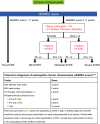Dupilumab efficacy in chronic rhinosinusitis with nasal polyps from SINUS-52 is unaffected by eosinophilic status
- PMID: 33993501
- PMCID: PMC9290136
- DOI: 10.1111/all.14906
Dupilumab efficacy in chronic rhinosinusitis with nasal polyps from SINUS-52 is unaffected by eosinophilic status
Abstract
Background: The human monoclonal antibody dupilumab blocks interleukin (IL)-4 andIL-13, key and central drivers of type 2 inflammation. Dupilumab, on background mometasone furoate nasal spray (MFNS), improved outcomes in the phase III SINUS-52 study (NCT02898454) in patients with severe chronic rhinosinusitis with nasal polyps (CRSwNP). This posthoc analysis of SINUS-52 examined whether eosinophilic status of CRSwNP was a predictor of dupilumab efficacy.
Methods: Patients were randomized 1:1:1 to dupilumab 300 mg every 2 weeks (q2w) until week 52; dupilumab 300 mg q2w until Week 24, then 300 mg every 4 weeks until week 52; or placebo (MFNS) until week 52. Coprimary endpoints were change from baseline in nasal polyps score (NPS), nasal congestion (NC), and Lund-Mackay score assessed by CT (LMK-CT) at week 24. Patients (n = 438) were stratified by eosinophilic chronic rhinosinusitis (ECRS) status according to the Japanese Epidemiological Survey of Refractory Eosinophilic Rhinosinusitis algorithm.
Results: Dupilumab significantly improved NPS, NC, and LMK-CT scores versus placebo at week 24 in all ECRS subgroups (p < 0.001), with improvements maintained or increased at week 52 (p < 0.001). There was no significant interaction between ECRS subgroup (non-/mild or moderate/severe) and dupilumab treatment effect for all endpoints at weeks 24 and 52 (p > 0.05), except LMK-CT at week 24 (p = 0.0275). Similar results were seen for the secondary endpoints. Dupilumab was well tolerated across all ECRS subgroups.
Conclusion: Dupilumab produced consistent improvement in symptoms of severe CRSwNP irrespective of ECRS status. Therefore, blood eosinophil level may not be a suitable biomarker for dupilumab efficacy in CRSwNP.
Keywords: ENT (rhinitis; biologics; eosinophils; inflammation; nasal polyps); sinusitis.
© 2021 The Authors. Allergy published by European Academy of Allergy and Clinical Immunology and John Wiley & Sons Ltd.
Conflict of interest statement
Fujieda S: AstraZeneca, GlaxoSmithKline, Kyowa Hakko Kirin, and Sanofi – advisory board member; Kyorin, Mitsubishi Tanabe Pharma, and Taiho Pharma – speaker fees. Matsune S: Sanofi – advisory board member; Kyorin, Meiji Seika Pharma, Mitsubishi Tanabe Pharma, Sanofi, Taiho Pharma, and Tanabe Pharma – speaker fees. Takeno S: Sanofi – advisory board member; Sanofi – speaker fees. Ohta N: Mitsubishi Tanabe Pharma, Sanofi, and Taiho Pharma– speaker fees. Asako M: AstraZeneca, Sanofi, and Taiho Pharma – speaker fees. Bachert C: ALK, ASIT Biotech, AstraZeneca, Intrexon Actobiotics, Novartis, Sanofi, Stallergenes Greer – advisory board member. Inoue T, Takahashi Y, Fujita H, Rowe P, Li Y, Mannent LP: Sanofi – employees, may hold stock and/or stock options in the company. Deniz Y, Ortiz B: Regeneron Pharmaceuticals, Inc. – employees and shareholders.
Figures



Similar articles
-
The Effect of Dupilumab on Intractable Chronic Rhinosinusitis with Nasal Polyps in Japan.Laryngoscope. 2021 Jun;131(6):E1770-E1777. doi: 10.1002/lary.29230. Epub 2020 Nov 23. Laryngoscope. 2021. PMID: 33226139 Free PMC article. Clinical Trial.
-
Efficacy and safety of dupilumab in patients with severe chronic rhinosinusitis with nasal polyps (LIBERTY NP SINUS-24 and LIBERTY NP SINUS-52): results from two multicentre, randomised, double-blind, placebo-controlled, parallel-group phase 3 trials.Lancet. 2019 Nov 2;394(10209):1638-1650. doi: 10.1016/S0140-6736(19)31881-1. Epub 2019 Sep 19. Lancet. 2019. PMID: 31543428 Clinical Trial.
-
Association Between Smell Loss, Disease Burden, and Dupilumab Efficacy in Chronic Rhinosinusitis with Nasal Polyps.Am J Rhinol Allergy. 2025 Jan;39(1):6-12. doi: 10.1177/19458924241274501. Epub 2024 Sep 19. Am J Rhinol Allergy. 2025. PMID: 39300794 Free PMC article. Clinical Trial.
-
Dupilumab: A Review in Chronic Rhinosinusitis with Nasal Polyps.Drugs. 2020 May;80(7):711-717. doi: 10.1007/s40265-020-01298-9. Drugs. 2020. PMID: 32240527 Review.
-
Dupilumab: Clinical Efficacy of Blocking IL-4/IL-13 Signalling in Chronic Rhinosinusitis with Nasal Polyps.Drug Des Devel Ther. 2020 May 8;14:1757-1769. doi: 10.2147/DDDT.S243053. eCollection 2020. Drug Des Devel Ther. 2020. PMID: 32440101 Free PMC article. Review.
Cited by
-
Distinct Gene Set Enrichment Profiles in Eosinophilic and Non-Eosinophilic Chronic Rhinosinusitis with Nasal Polyps by Bulk RNA Barcoding and Sequencing.Int J Mol Sci. 2022 May 18;23(10):5653. doi: 10.3390/ijms23105653. Int J Mol Sci. 2022. PMID: 35628459 Free PMC article.
-
Differential Immune Cell Infiltration in Eosinophilic and Non-Eosinophilic CRS: Correlations With Clinical, Endoscopic, and Radiological Findings.Int Forum Allergy Rhinol. 2025 Aug;15(8):779-787. doi: 10.1002/alr.23563. Epub 2025 Mar 11. Int Forum Allergy Rhinol. 2025. PMID: 40067202 Free PMC article.
-
Management of eosinophil-associated inflammatory diseases: the importance of a multidisciplinary approach.Front Immunol. 2023 May 17;14:1192284. doi: 10.3389/fimmu.2023.1192284. eCollection 2023. Front Immunol. 2023. PMID: 37266434 Free PMC article.
-
Biologic Therapies across Nasal Polyp Subtypes.J Pers Med. 2024 Apr 19;14(4):432. doi: 10.3390/jpm14040432. J Pers Med. 2024. PMID: 38673059 Free PMC article. Review.
-
The effect of biologics in lung function and quality of life of patients with united airways disease: A systematic review.J Allergy Clin Immunol Glob. 2023 Sep 28;3(1):100174. doi: 10.1016/j.jacig.2023.100174. eCollection 2024 Feb. J Allergy Clin Immunol Glob. 2023. PMID: 37915724 Free PMC article.
References
-
- Khan A, Vandeplas G, Huynh TMT, et al. The Global Allergy and Asthma European Network (GALEN) rhinosinusitis cohort: a large European cross‐sectional study of chronic rhinosinusitis patients with and without nasal polyps. Rhinology. 2019;57:32‐42. - PubMed
-
- Fokkens WJ, Lund VJ, Hopkins C, et al. European position paper on rhinosinusitis and nasal polyps 2020. Rhinology. 2020;58:1‐464. - PubMed
-
- Klonaris D, Doulaptsi M, Karatzanis A, Velegrakis S, Milioni A, Prokopakis E. Assessing quality of life and burden of disease in chronic rhinosinusitis: a review. Rhinology Online. 2019;2:6‐13.
Publication types
MeSH terms
Substances
Associated data
LinkOut - more resources
Full Text Sources
Other Literature Sources
Medical
Research Materials
Miscellaneous

